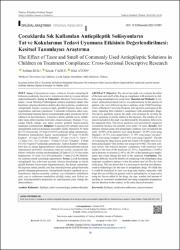| dc.contributor.author | İzol, Aslıhan | |
| dc.contributor.author | Yazıcı, Selçuk | |
| dc.contributor.author | Aydın, Hilal | |
| dc.date.accessioned | 2024-12-06T12:43:53Z | |
| dc.date.available | 2024-12-06T12:43:53Z | |
| dc.date.issued | 2024 | en_US |
| dc.identifier.issn | 2146-8990 | |
| dc.identifier.uri | https://doi.org/10.5336/pediatr.2023-101081 | |
| dc.identifier.uri | https://hdl.handle.net/20.500.12462/15492 | |
| dc.description.abstract | Çalışmamızın amacı, solüsyon formda antiepileptik
kullanan çocuklarda, ilacın tat ve kokularının tedaviye uyuma etkisini
değerlendirmektir. Gereç ve Yöntemler: Balıkesir Üniversitesi Hastanesi, Çocuk Nöroloji Polikliniğinde epilepsi nedeniyle takipli olan
hastaların çalışmaya katılmayı kabul eden ebeveynlerine, çocuklarının
antiepileptik ilaçlara uyumuyla ilgili, gönüllü katılıma dayalı anket
uygulanması şeklinde yapılmıştır. Çalışmada kullanılan anket soruları literatürde bulunan benzer çalışmalardaki anket sorularının revize
edilmesi ile hazırlanmıştır. Çalışmaya alınan gönüllü sayısı poliklinikte takip edilen hastalar üzerinden oluşturulmuştur. Hastalar 18 yaşından küçük olduğu için anket soruları gönüllü bakımverenler
tarafından yanıtlanmıştır. Bulgular: Çalışmaya 102 epilepsi tanılı oral
antiepileptik solüsyon kullanan hasta dâhil edildi. Hastaların 83’ünün
(81,37) monoterapi, 19’unun (%18,63) politerapi aldığı saptanmıştır.
Hastaların kullandıkları ilaçlar incelendiğinde 47’sinin (%46,08)
Keppra®, 26’sının (%25,49) Depakin®, 15’inin (%14,71) Epixx®,
12’sinin (%11,76) Convulex®, 4’ünün (%3,92) Trileptal®, 4’ünün
(%3,92) Tegretol® kullandığı saptanmıştır. Sadece Keppra® kullananların ilacı iyi olarak değerlendirmesi oranı kullanmayanlardan yüksek
saptanmıştır (p=0,042). Hastaların tedaviye uyumu zorlaştıran faktörlere verdikleri yanıtlar incelendiğinde 24’ünün (%23,53) ilaç tadını
beğenmeme, 16’sının (%15,69) unutkanlık, 3’ünün (%2,94) nöbetlerin azalması olarak yanıtladığı saptanmıştır. Sonuç: Çocuk hastalarda
antiepileptik ilaç tedavisine uyumda ailelerin karşılaştığı en büyük
güçlük hastanın ilacın tadını beğenmemesidir. Bu durum, antiepileptik ilaçların tadına yönelik yeni ilaç teknolojilerinin geliştirilmesinin
gerekli olduğunu göstermiştir. Antiepileptik ilaçlarla yapılacak tat çalışmalarının, eklenen aromalar, yardımcı veya tatlandırıcı maddelerin
çeşit, sayı ve miktarının standardize edildiği, özdeş, aynı fiziksel yapıda, karşılaştırılabilir preparatlar ile yapılmasında yarar olduğu düşüncesindeyiz. | en_US |
| dc.description.abstract | The aim of our study is to evaluate the effect
of the taste and smell of the drug on compliance with treatment in children using antiepileptics in syrup form. Material and Methods: A voluntary participation-based survey was administered to the parents of
patients who were followed up due to epilepsy at the Child Neurology
Clinic of Balıkesir University Hospital, who agreed to participate in the
study, regarding their children’s compliance with antiepileptic drugs.
The survey questions used in the study were prepared by revising the
survey questions in similar studies in the literature. The number of volunteers included in the study was determined by the patients followed in
the outpatient clinic. The survey questions were answered by caregivers
voluntiarily because the patients were under 18 years. Results: 102
epileptic patients using oral antiepileptic solutions were included in the
study. 46.08% of the patients were using Keppra®, 25.49% were using
Depakin®, 14.71% were using Epixx®, 11.76% were using Convulex®,
3.92% were using Trileptal®, and 3.92% were using Tegretol®. The rate
of evaluating the drug taste as good was found to be higher only in patients using Keppra® than in those not using it (p=0.042). The most common factors that reduced patients’ compliance with treatment were
dislike of the taste of the medicine (23.53%), forgetfulness (15.69%)
and a decrease in seizures (2.94%). 40.20% of the parents gave supplements that would change the taste of the medicine. Conclusion: The
biggest difficulty faced by families in complying with antiepileptic drug
treatment in pediatric patients is that the patient does not like the taste
of the drug. This has shown that it is necessary to develop new pharmaceutical technologies for the taste of antiepileptic drugs. We think that
it would be beneficial to carry out drug taste studies, especially with
drugs that are not liked in general, such as antiepileptics, in large series
using the flavors added to the drugs, the type, number and amount of
auxiliary or sweeteners standardized and using comparable preparations
that are identical in this respect, in the same physical structure. | en_US |
| dc.language.iso | tur | en_US |
| dc.publisher | Türkiye Klinikleri Yayınevi | en_US |
| dc.relation.isversionof | 10.5336/pediatr.2023-101081 | en_US |
| dc.rights | info:eu-repo/semantics/openAccess | en_US |
| dc.rights.uri | http://creativecommons.org/licenses/by-nc-nd/3.0/us/ | * |
| dc.subject | Epilepsi | en_US |
| dc.subject | Tedavi Uyumsuzluğu | en_US |
| dc.subject | Antikonvülzanlar | en_US |
| dc.subject | Epilepsy | en_US |
| dc.subject | Medication Adherence | en_US |
| dc.subject | Anticonvulsants | en_US |
| dc.title | Çocuklarda sık kullanılan antiepileptik solüsyonların tat ve kokularının tedavi uyumuna etkisinin değerlendirilmesi: Kesitsel tanımlayıcı araştırma | en_US |
| dc.title.alternative | The effect of taste and smell of commonly used antiepileptic solutions in children on treatment compliance: Cross-sectional descriptive research | en_US |
| dc.type | article | en_US |
| dc.relation.journal | Türkiye Klinikleri Pediatri Dergisi | en_US |
| dc.contributor.department | Tıp Fakültesi | en_US |
| dc.contributor.authorID | 0000-0002-9957-1828 | en_US |
| dc.contributor.authorID | 0000-0002-6526-9460 | en_US |
| dc.contributor.authorID | 0000-0002-2448-1270 | en_US |
| dc.identifier.volume | 33 | en_US |
| dc.identifier.issue | 1 | en_US |
| dc.identifier.startpage | 16 | en_US |
| dc.identifier.endpage | 24 | en_US |
| dc.relation.publicationcategory | Makale - Uluslararası Hakemli Dergi - Kurum Öğretim Elemanı | en_US |




















